The Effect of Low-Temperature Plasma Treatment on the Adhesive Bonding Performance of CF/PEKK Surfaces
Abstract
1. Introduction
2. Materials and Methods
2.1. Experimental Materials
2.2. Surface Treatment Equipment
- (1)
- Generation of low-temperature plasma:
- (2)
- Plasma output:
2.3. Fabrication of Adhesively Bonded Specimens and Mechanical Characterization
2.4. Experimental Testing and Analysis Methods
2.4.1. Single-Lap Tensile Shear Test
2.4.2. Characterization of Surface Wettability
2.4.3. Scanning Electron Microscopy (SEM) Analysis
2.4.4. X-Ray Photoelectron Spectroscopy (XPS) Analysis
2.4.5. Fourier Transform Infrared Spectroscopy (FT-IR) Analysis
3. Results
3.1. Analysis of Single Overlap Shear Test Results
3.2. Surface Wettability Analysis of CF/PEKK
3.3. Microscopic Morphology Analysis of CF/PEKK Surface
3.4. Analysis of Surface Chemical Composition of CF/PEKK
4. Conclusions
- Compared to other treatment methods, plasma treatment improves the surface properties of CF/PEKK and enhances its adhesive strength. Among various plasma treatment parameter combinations, the adhesive strength of CF/PEKK reached a maximum of 28.28 MPa when the parameters were set to P10–5 (i.e., a treatment speed of 10 mm/s and a treatment distance of 5 mm). After plasma treatment, the failure mode of the adhesive joints shifted from interfacial failure (as seen in untreated specimens) to a mixed failure mode of cohesive and substrate failure, significantly enhancing the bonding between the adhesive and CF/PEKK.
- After plasma treatment, both the wettability and surface adsorption properties of CF/PEKK are improved. The contact angle of the CF/PEKK surface decreases gradually as the plasma treatment distance and speed are reduced, with a notable increase in both the total surface free energy and its polar component. However, there exists a saturation point for the wettability of the CF/PEKK surface, such that further reductions in treatment parameters do not significantly enhance surface wettability.
- Plasma treatment leaves distinct etching marks on the CF/PEKK surface, making it noticeably rougher and producing numerous groove-like textures. This effectively increases the bonding area of the CF/PEKK surface, improves the mechanical interlocking between the adhesive and the composite, and thereby enhances the adhesive joint strength.
- Following plasma treatment, the surface activity of CF/PEKK increases. The active species in the plasma impact the CF/PEKK surface and form more reactive oxygen-containing functional groups, such as C-O-C and O-C=O. These groups facilitate the formation of stronger chemical bonds with the epoxy resin adhesive, which is a key factor in the enhanced adhesive joint strength of CF/PEKK.
Supplementary Materials
Author Contributions
Funding
Data Availability Statement
Conflicts of Interest
References
- Shoaib, M.; Jamshaid, H.; Alshareef, M.; Alharthi, F.A.; Ali, M.; Waqas, M. Exploring the Potential of Alternate Inorganic Fibers for Automotive Composites. Polymers 2022, 14, 4946. [Google Scholar] [CrossRef]
- Sayam, A.; Rahman, A.N.M.M.; Rahman, M.S.; Smriti, S.A.; Ahmed, F.; Rabbi, M.F.; Hossain, M.; Faruque, M.O. A review on carbon fiber-reinforced hierarchical composites: Mechanical performance, manufacturing process, structural applications and allied challenges. Carbon Lett. 2022, 32, 1173–1205. [Google Scholar] [CrossRef] [PubMed]
- Tian, L.; Zhang, P.; Xian, G. Continuous fiber reinforced thermoplastic composite pultrusion with in situ polymerizable methyl methacrylate: A review. Polym Compos. 2023, 44, 4345–4369. [Google Scholar] [CrossRef]
- Adeniran, O.; Cong, W.L.; Oluwabunmi, K. Thermoplastic matrix material influences on the mechanical performance of additively manufactured carbon-fiber-reinforced plastic composites. J. Compos. Mater. 2022, 56, 1391–1405. [Google Scholar] [CrossRef]
- Perez-Martin, H.; Mackenzie, P.; Baidak, A.; Bradaigh, C.M.O.; Ray, D. Crystallisation behaviour and morphological studies of PEKK and carbon fibre/PEKK composites. Compos. Part A Appl. Sci. Manuf. 2022, 159, 106992. [Google Scholar] [CrossRef]
- Perez-Martin, H.; Mackenzie, P.; Baidak, A.; Brádaigh, C.M.Ó.; Ray, D. Crystallinity studies of PEKK and carbon fibre/PEKK composites: A review. Compos. Part B Eng. 2021, 223, 109127. [Google Scholar] [CrossRef]
- Quiroga Cortés, L.; Caussé, N.; Dantras, E.; Lonjon, A.; Lacabanne, C. Morphology and dynamical mechanical properties of poly ether ketone ketone (PEKK) with meta phenyl links. J. Appl. Polym. Sci. 2016, 133, 43396. [Google Scholar] [CrossRef]
- Li, Y.; Xiao, Y.; Yu, L.; Ji, K.; Li, D. A review on the tooling technologies for composites manufacturing of aerospace structures: Materials, structures and processes. Compos. Part A Appl. Sci. Manuf. 2022, 154, 106762. [Google Scholar] [CrossRef]
- Deng, S.; Wu, J.; Dickey, M.D.; Zhao, Q.; Xie, T. Rapid Open-Air Digital Light 3D Printing of Thermoplastic Polymer. Adv. Mater. 2019, 31, 1903970. [Google Scholar] [CrossRef]
- Chen, W.; Li, Y.; Feng, S. Analysis and Prospect of Assembly Technology of Aircraft Composite Fuselage Panel. Aeronaut. Manuf. Technol. 2024, 67, 59–73. [Google Scholar]
- Ramezani, F.; Simões, B.D.; Carbas, R.J.C.; Marques, E.A.S.; da Silva, L.F.M. Developments in Laminate Modification of Adhesively Bonded Composite Joints. Materials. 2023, 16, 568. [Google Scholar] [CrossRef] [PubMed]
- Kantharaju, S.; Vinodhini, J.; M, G.; Bhowmik, S. An investigation to enhance the mechanical property of high-performance thermoplastic composite through different plasma treatment. Polym Compos. 2023, 44, 178–189. [Google Scholar] [CrossRef]
- Yang, G.; Yang, T.; Yuan, W.; Du, Y. The influence of surface treatment on the tensile properties of carbon fiber-reinforced epoxy composites-bonded joints. Compos. Part B Eng. 2019, 160, 446–456. [Google Scholar] [CrossRef]
- del Olmo, R.; Tiringer, U.; Milosev, I.; Visser, P.; Arrabal, R.; Matykina, E.; Mol, J.M.C. Hybrid sol-gel coatings applied on anodized AA2024-T3 for active corrosion protection. Surf. Coat. Technol. 2021, 419, 127251. [Google Scholar] [CrossRef]
- Choi, B.K.; Kang, C.S.; Yoo, M.H.; Seo, M.K. Effect of Processing Parameters on Bonding Performance of a Carbon Fiber/Polyetheretherketone Thermoplastic Composite Prepared by Induction Welding. Materials 2023, 16, 3954. [Google Scholar] [CrossRef]
- Pitto, M.; Fiedler, H.; Kim, N.K.; Verbeek, C.J.R.; Allen, T.D.; Bickerton, S. Carbon fibre surface modification by plasma for enhanced polymeric composite performance: A review. Compos. Part A Appl. Sci. Manuf. 2024, 180, 108087. [Google Scholar] [CrossRef]
- Bertin, M.; Leitao, E.M.; Bickerton, S.; Verbeek, C.J.R. A review of polymer surface modification by cold plasmas toward bulk functionalization. Plasma Process. Polym. 2024, 21, 2300208. [Google Scholar] [CrossRef]
- Avci, R.; Cakici, U.G.; Cetinkaya, B.; Oktem, M.F. Effect of atmospheric plasma treatment and wet blast on adhesion characteristics of carbon fiber reinforced LM-PAEK thermoplastic composites. Compos. Part B Eng. 2024, 278, 111394. [Google Scholar] [CrossRef]
- Zhao, Y.; Zhao, G.; Li, M.; Ge, Y.; Xu, J. The Effect of Surface Treatment on the Resistance Welding Technology for Carbon Fiber/Epoxy Resin Composites. Appl. Compos. Mater. 2024, 31, 201–221. [Google Scholar] [CrossRef]
- Paranjpe, N.; Uddin, M.N.; Rahman, A.S.; Asmatulu, R. Effects of Surface Treatment on Adhesive Performance of Composite-to-Composite and Composite-to-Metal Joints. Processes 2024, 12, 2623. [Google Scholar] [CrossRef]
- Guo, W.; Lim, Y.C.; Ong, C.H.; Kumar, A.S. Atmospheric pressure plasma application on the adhesive bonding improvement of CFRP via surface configuration comparison. Polym. Compos. 2024, 45, 1461–1471. [Google Scholar] [CrossRef]
- Zhang, X.; Ye, W.; Long, X.; Cao, H.; Sun, Q.; Ma, Y.; Wang, Z. Interfacial bonding properties of ultra-high molecular weight polyethylene fabric/thermoplastic polyurethane composites. J. Text. Res. 2023, 44, 143–150. [Google Scholar]
- Sun, C.; Min, J.; Lin, J.; Wan, H. Effect of Atmospheric Pressure Plasma Treatment on Adhesive Bonding of Carbon Fiber Reinforced Polymer. Polymers 2019, 11, 139. [Google Scholar] [CrossRef]
- Nandi, A.; Kumar Biswal, A.; Nguyen, A.; Nordyke, L.; Behling, E.; Foulds, T.; Schultz, K.; Vashisth, A. Comparative study of surface preparation for paint adhesion on CF-PEKK composites: Plasma, Chemical, and Flame treatment. Appl. Surf. Sci. 2024, 669, 160533. [Google Scholar] [CrossRef]
- ASTM D3359-23; Standard Test Methods for Measuring Adhesion by Tape Test. American Society for Testing and Materials: West Conshohocken, PA, USA, 2023.
- Li, C.; Zhang, J.; Sun, F.; Liu, G.; Blackman, B.R.K.; Si, Y.; Yu, J. Effect of low-pressure plasma processing parameters on the surface topography of a CF/PEEK composite for adhesive bonding. Polym. Compos. 2024, 45, 11212–11222. [Google Scholar] [CrossRef]
- GB/T 33334-2016; Test Method for Strength Properties of Adhesives in Shear by Tension Loading of Single-Lap-Joint Laminated Assemblies (Composite and Composite). China Standard Press: Beijing, China, 2016.
- Wen, L.; Xu, X.; Qin, L. Effect of Low-Temperature Plasma Surface Treatment on Bonding Properties of Single-Lap Joint of Thermosetting Composites. Polymers 2023, 15, 1631. [Google Scholar] [CrossRef] [PubMed]
- Wen, L.; Wang, R.; Xu, E. Optimization and Mechanism Study of Bonding Properties of CFRP/Al7075 Single-Lap Joints by Low-Temperature Plasma Surface Treatment. Coatings 2024, 14, 541. [Google Scholar] [CrossRef]
- Shin, Y.; Qiao, Y.; Canfield, N.; Yu, Z.; Meyer, H.M., III.; Merkel, D.R.; Nickerson, E.K.; Kanbargi, N.S.; Ortiz, A.; Naskar, A.K.; et al. Significant slowdown of plasma-optimized surface energy deactivation by vacuum sealing for efficient adhesive bonding. Compos. Part B Eng. 2022, 240, 110001. [Google Scholar] [CrossRef]
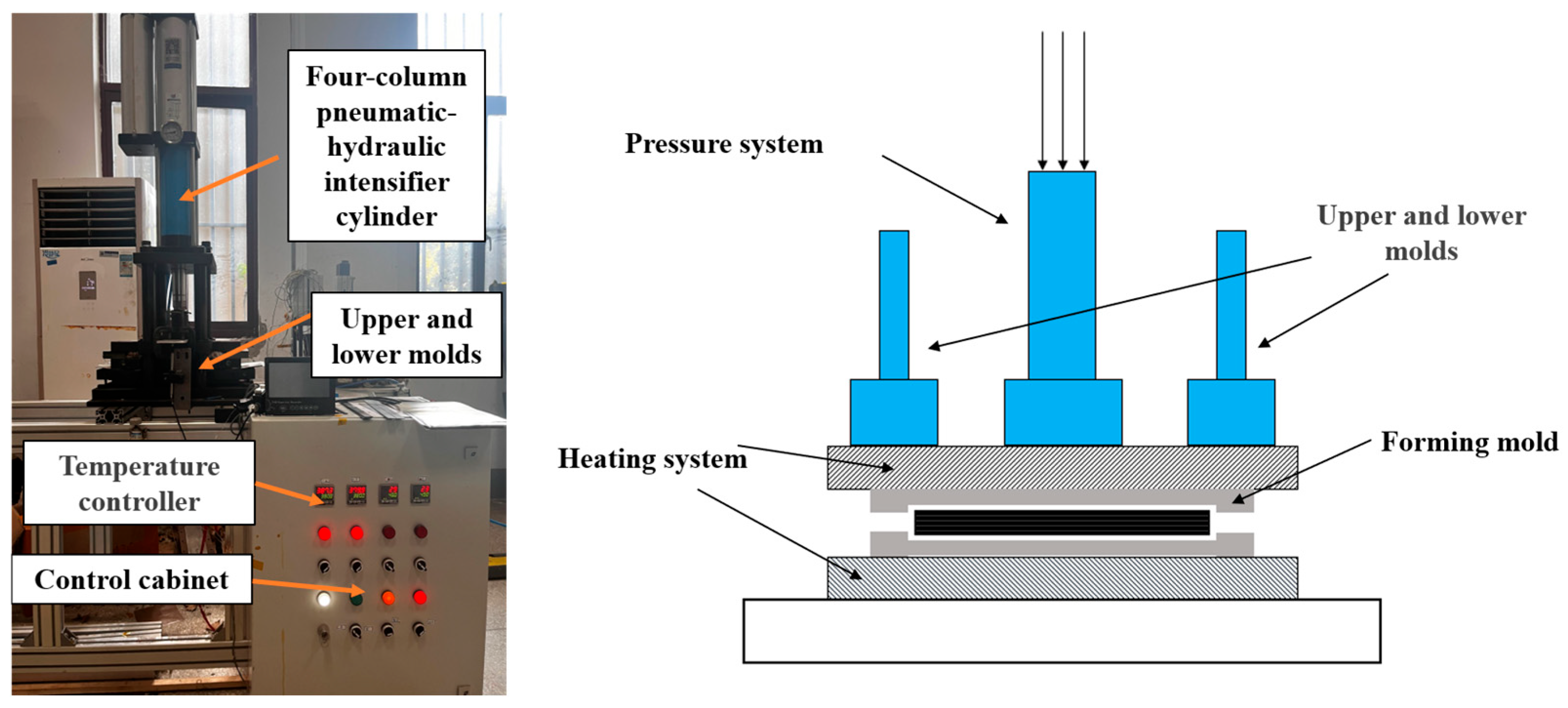
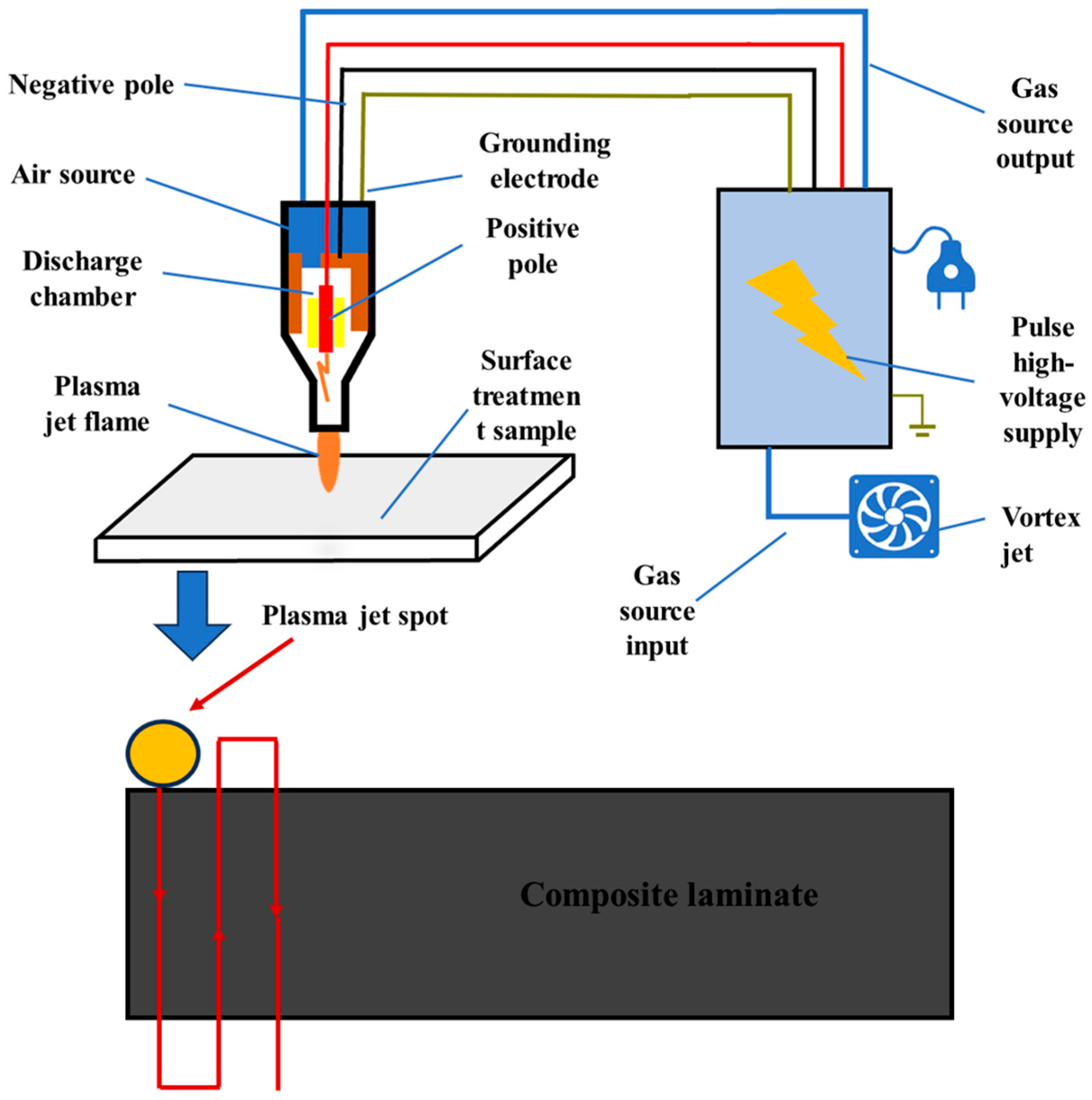
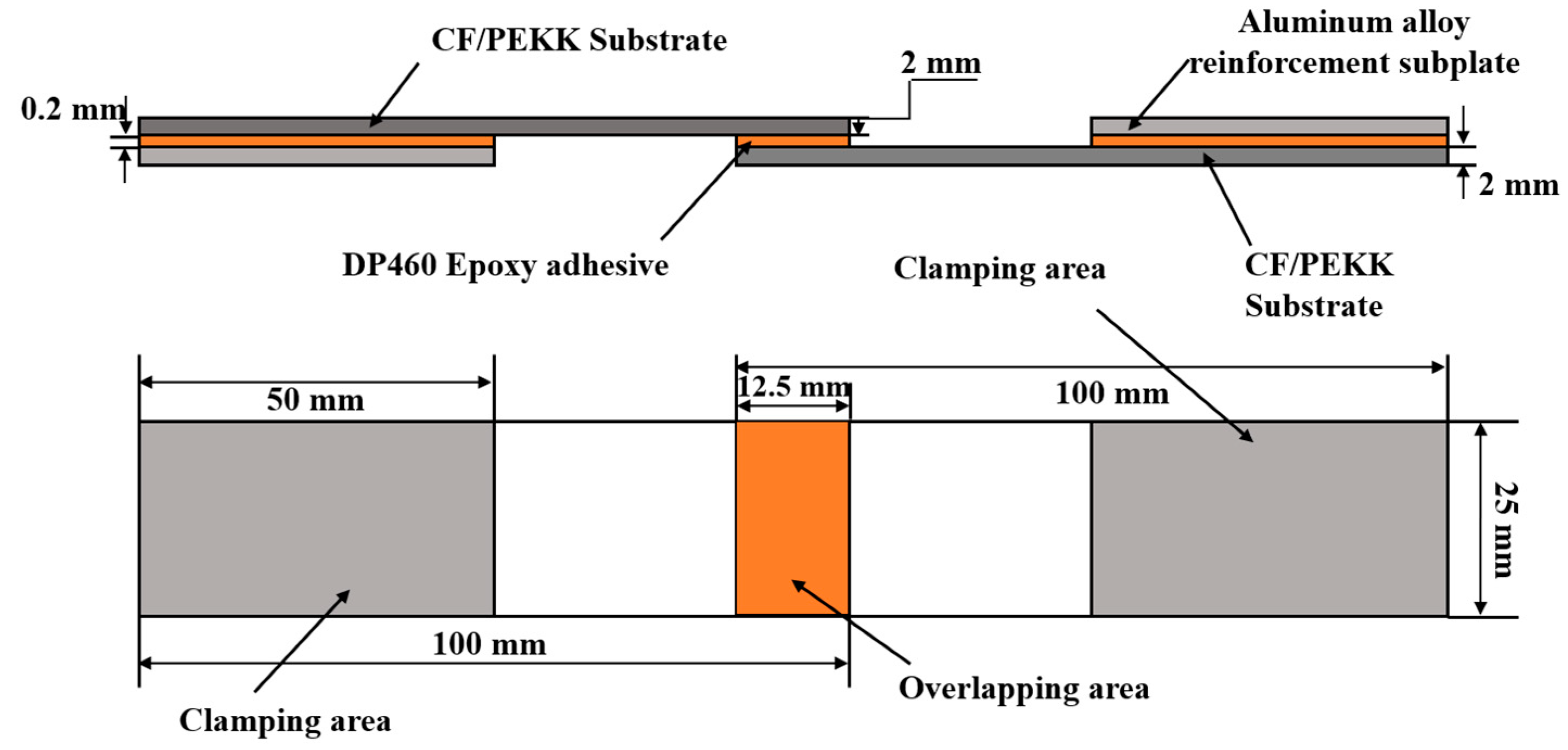

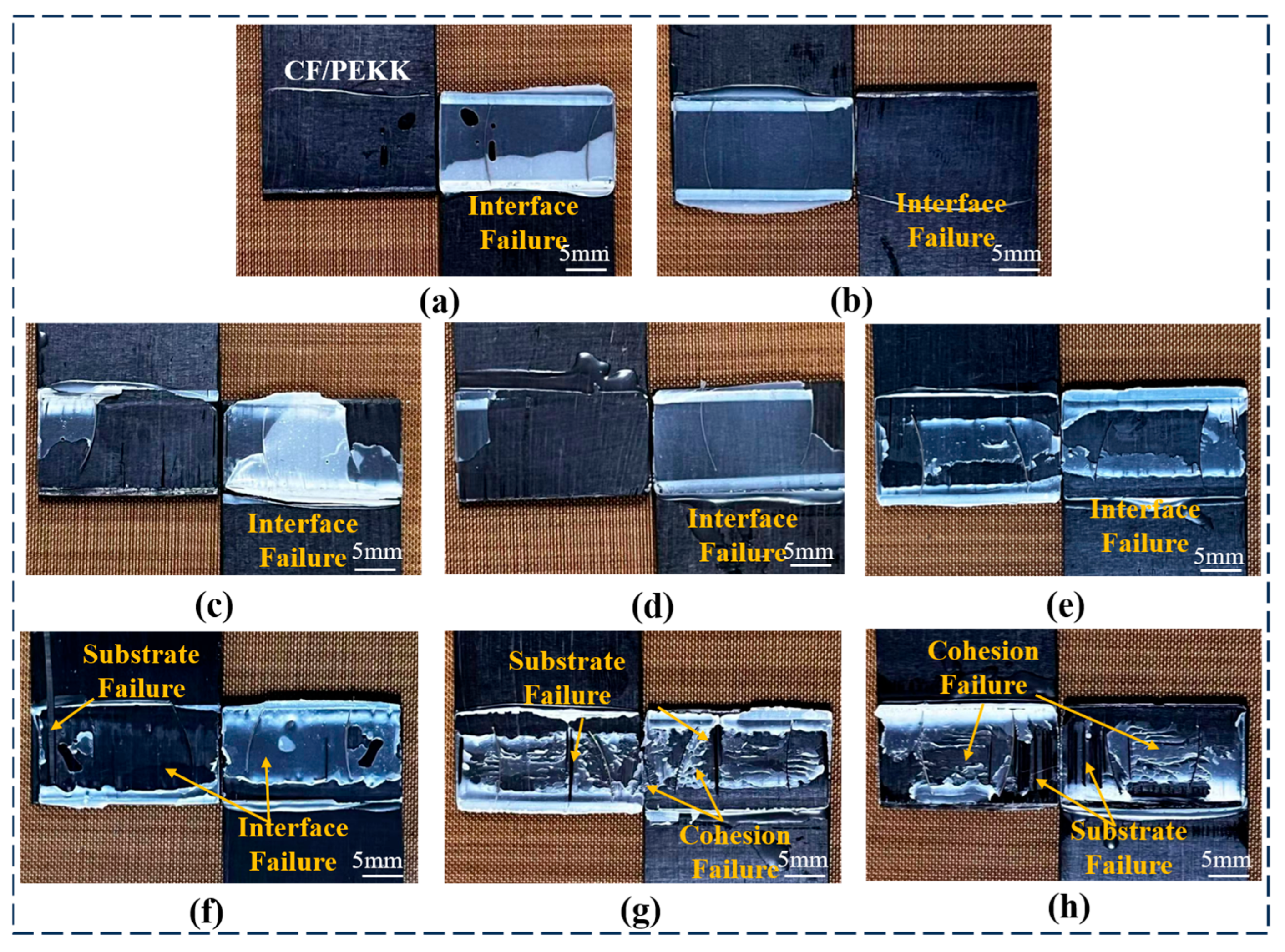
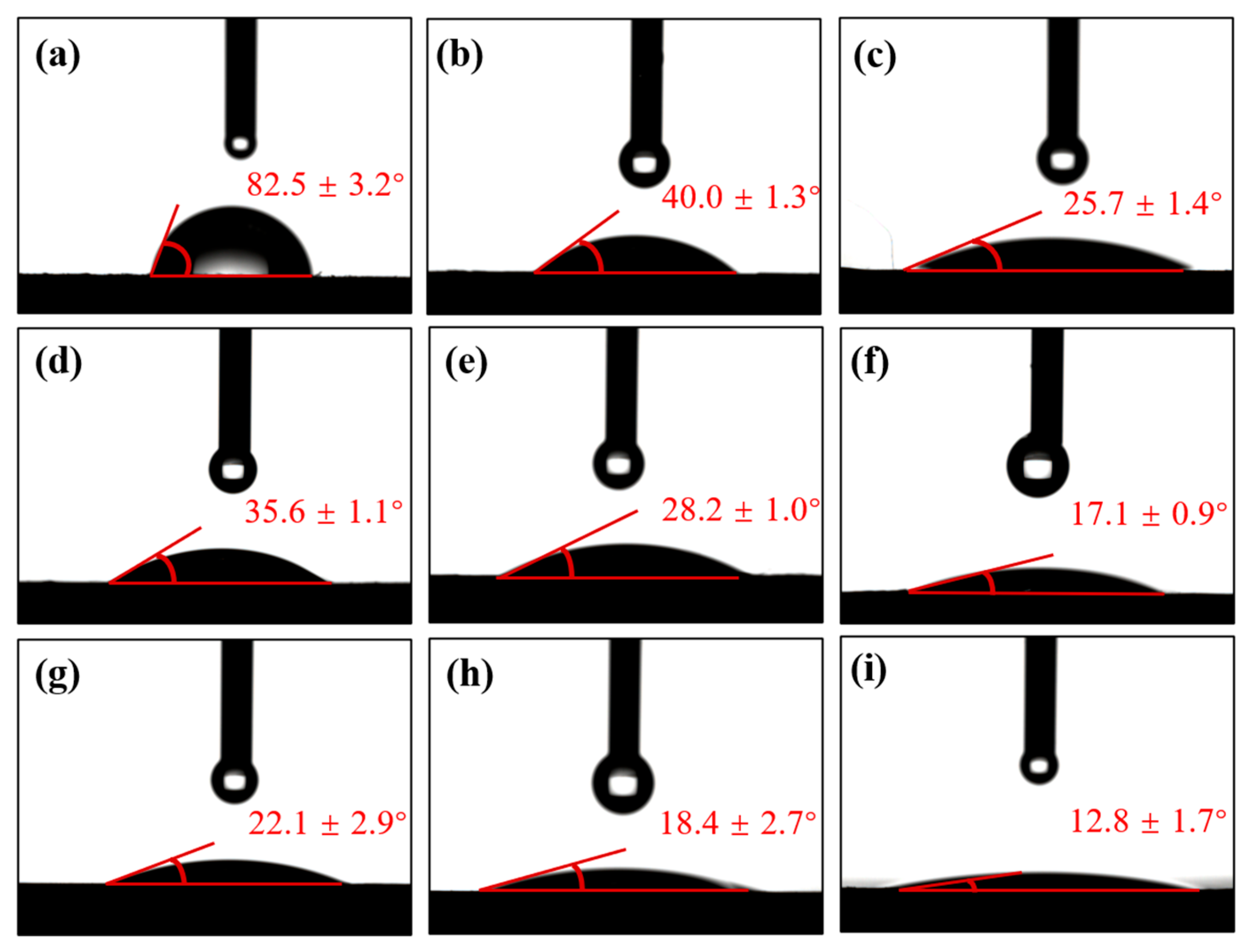

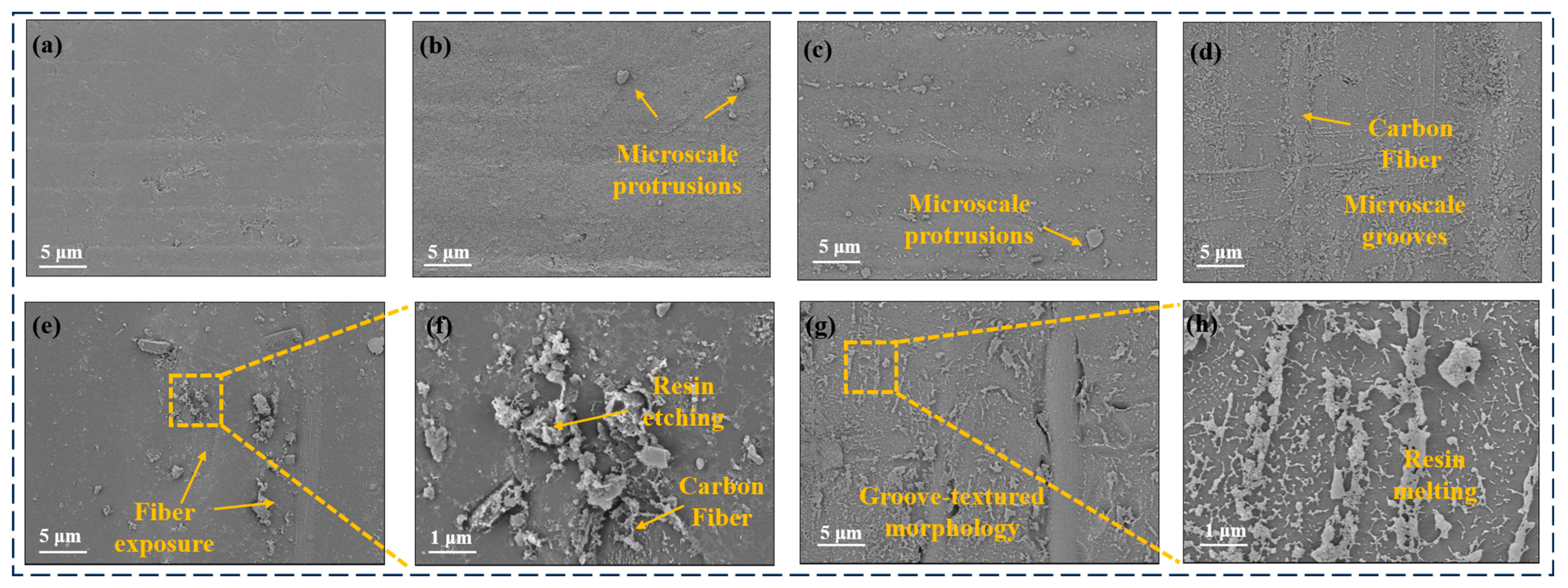

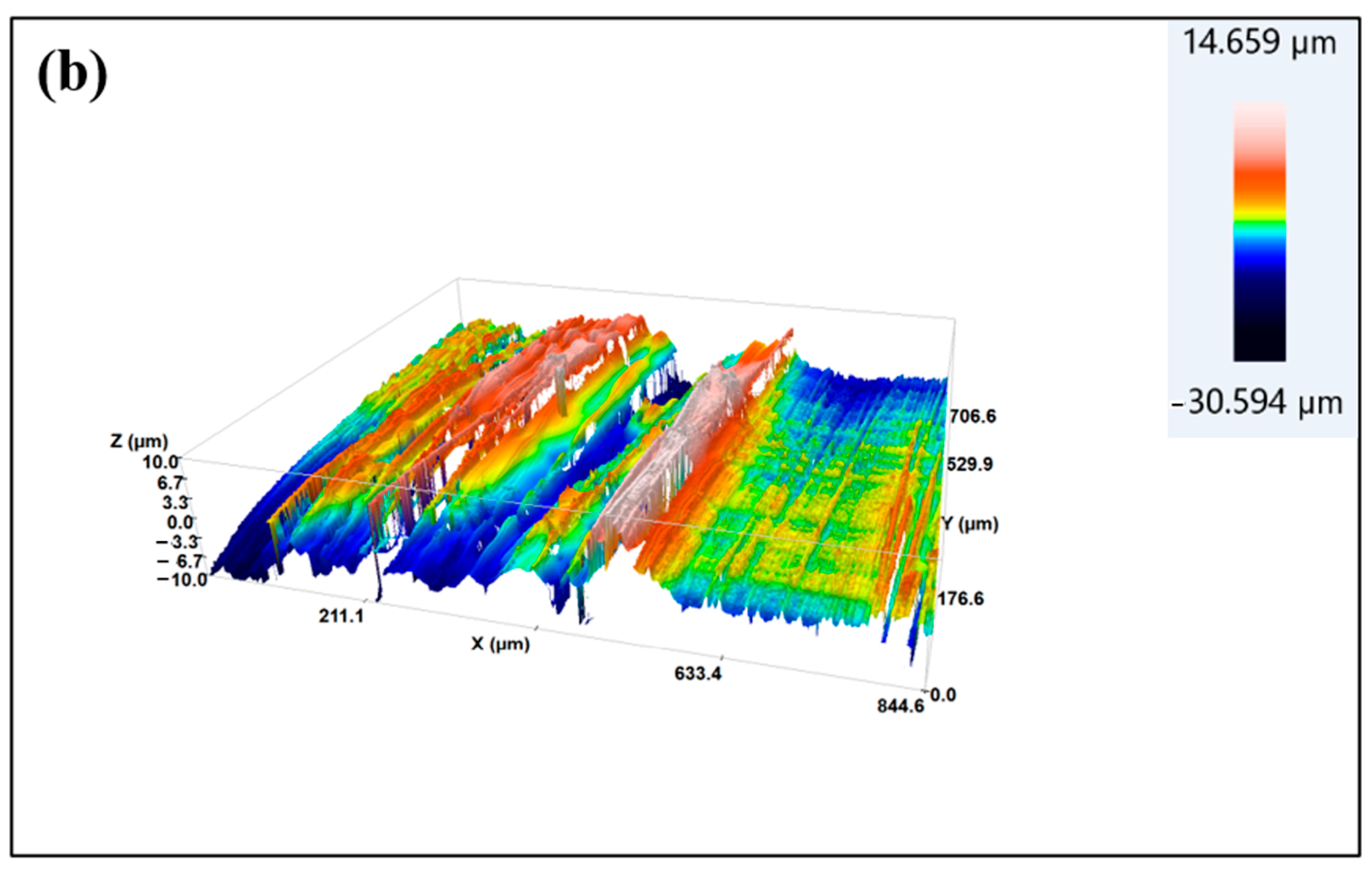
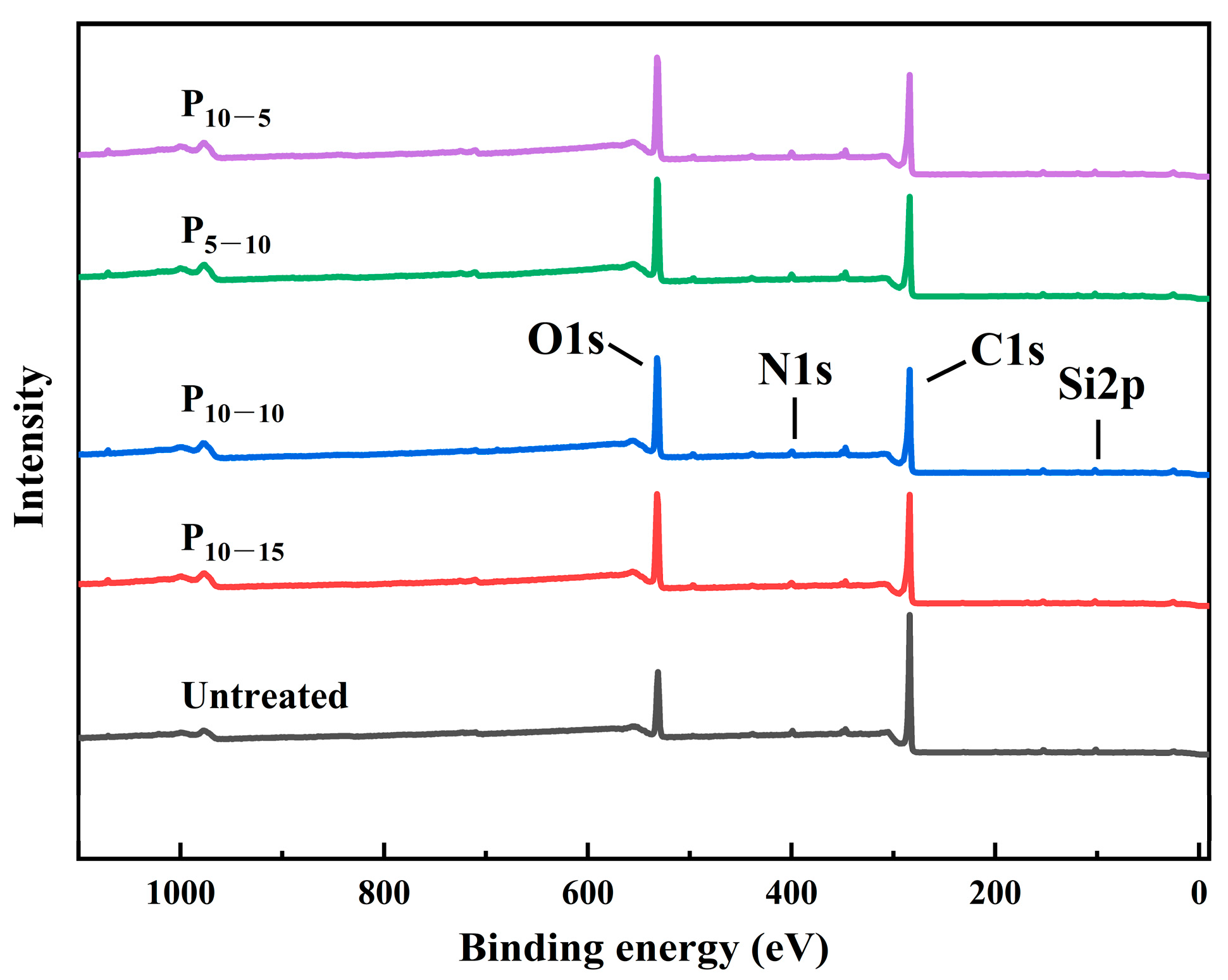


| Density | Tensile Strength | Tensile Modulus | Tensile Elongation | Melting Temperature |
|---|---|---|---|---|
| 1.31 g/cm3 | 102 MPa | 4.5 GPa | 4% | 337 °C |
| Elastic Modulus | Tensile Strength | Shear Strength | Elongation at Break | Curing Time |
|---|---|---|---|---|
| 2.7 GPa | 37 MPa | 32 MPa | 4% | 4 h |
| Related Elements | Samples | |||||||||
|---|---|---|---|---|---|---|---|---|---|---|
| Untreated | P10–15 | P10–10 | P5–10 | P10–5 | ||||||
| E [eV] | [at.%] | E [eV] | [at.%] | E [eV] | [at.%] | E [eV] | [at.%] | E [eV] | [at.%] | |
| C1s | 284.01 | 75.6 | 284.18 | 67.8 | 284.14 | 66.1 | 284.16 | 65.4 | 284.12 | 64.5 |
| O1s | 531.04 | 19.7 | 531.57 | 27.3 | 531.52 | 29.0 | 531.45 | 30.0 | 531.43 | 30.7 |
| N1s | 399.14 | 2.3 | 399.62 | 2.8 | 399.48 | 2.1 | 399.47 | 2.2 | 399.38 | 2.7 |
| Si2p | 101.74 | 2.2 | 101.37 | 1.6 | 101.73 | 2.3 | 101.71 | 1.9 | 101.47 | 1.3 |
| O/C | 0.26 | 0.40 | 0.44 | 0.46 | 0.48 | |||||
| N/C | 0.03 | 0.04 | 0.03 | 0.03 | 0.04 | |||||
| Surface Treatment | Relative Content of C1s Groups (Atomic/%) | Polar Groups/Non-Polar Groups | ||
|---|---|---|---|---|
| C-C | C-O-C | O-C=O | ||
| Untreated | 75.4 | 22.9 | 1.7 | 0.33 |
| P10–15 | 66.3 | 22.9 | 10.8 | 0.51 |
| P10–10 | 65.4 | 24.6 | 10.0 | 0.53 |
| P10–5 | 61.3 | 26.3 | 12.4 | 0.63 |
Disclaimer/Publisher’s Note: The statements, opinions and data contained in all publications are solely those of the individual author(s) and contributor(s) and not of MDPI and/or the editor(s). MDPI and/or the editor(s) disclaim responsibility for any injury to people or property resulting from any ideas, methods, instructions or products referred to in the content. |
© 2025 by the authors. Licensee MDPI, Basel, Switzerland. This article is an open access article distributed under the terms and conditions of the Creative Commons Attribution (CC BY) license (https://creativecommons.org/licenses/by/4.0/).
Share and Cite
Wen, L.; Dong, Z.; Wang, R. The Effect of Low-Temperature Plasma Treatment on the Adhesive Bonding Performance of CF/PEKK Surfaces. Surfaces 2025, 8, 41. https://doi.org/10.3390/surfaces8030041
Wen L, Dong Z, Wang R. The Effect of Low-Temperature Plasma Treatment on the Adhesive Bonding Performance of CF/PEKK Surfaces. Surfaces. 2025; 8(3):41. https://doi.org/10.3390/surfaces8030041
Chicago/Turabian StyleWen, Liwei, Zhentao Dong, and Ruozhou Wang. 2025. "The Effect of Low-Temperature Plasma Treatment on the Adhesive Bonding Performance of CF/PEKK Surfaces" Surfaces 8, no. 3: 41. https://doi.org/10.3390/surfaces8030041
APA StyleWen, L., Dong, Z., & Wang, R. (2025). The Effect of Low-Temperature Plasma Treatment on the Adhesive Bonding Performance of CF/PEKK Surfaces. Surfaces, 8(3), 41. https://doi.org/10.3390/surfaces8030041







